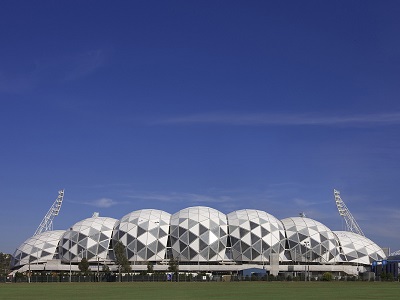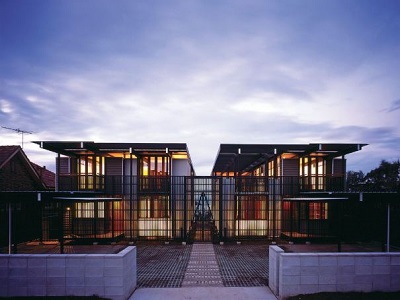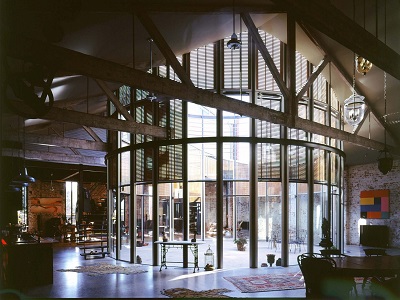Architecture & Design’s take on who are the 10 best contemporary or should we say modern male and female Australian architects.
Australian architecture is distinctive in many ways. Building design in Australia is essentially influenced by the country’s natural environment, landscape, culture and climate as well as its people. When buildings are designed in response to these elements, both creativity and practicality come into play and great architecture is born.
Australian architecture is also an honest expression of its multicultural identity – one can often experience influences of global architectural styles in many of the builds across the country.
While Indigenous architecture goes back millennia, Australia’s built environment since the late 18th century has evolved through a series of architectural styles beginning with Georgian and progressing through Victorian, Federation, Art Deco, post-war and mid-century modern to today’s contemporary, which has sustainability at its core that influences every aspect of the building process including design, materiality and execution.
Several architects have pushed the boundaries of design, leaving inspirational examples of their work as an enduring legacy for future generations of Australian designers. Pritzker Prize-winning Australian architect Glenn Murcutt doesn’t design overseas projects, yet he has been able to put Australian architecture on the world map. Phillip Cox is another Australian icon – the founding partner of COX Architects, which has executed projects across the globe.
Austrian-born Harry Seidler established himself as one of the leading practitioners of the Modernist style in Australia over a six-decade career. Trailblazers such as Brit Andresen, Clare Cousins and Kerstin Thompson continue to set an example for young women across Australia with their accomplishments.
Then there have been architects who brought their creative talents to Australia and left an indelible impact: Danish architect Jørn Utzon with his genius work on the Sydney Opera House and British-Iraqi architect Zaha Hadid – the first woman to be awarded the Pritzker Prize.
- Glenn Murcutt
The only Australian to win the Pritzker Architecture Prize
Simplicity has been the underlying theme of Glenn Murcutt’s architectural design style. Considered Australia’s most famous architect with a global reputation, Murcutt is inspired by the Aboriginal way of life, which is based on ‘touching the land lightly’. His deep respect for the environment comes through in his designs and material choices. While his creations give due consideration to the natural environment in and around the site, his materials palette is extremely localised, minimising the ecological impact of his build.
Some of Murcutt’s well known projects include: Fredericks/ White House, Jamberoo, New South Wales; Magney House, Bingie Point, New South Wales; Simpson-Lee House, Mount Wilson, Blue Mountains, New South Wales; Marika-Alderton House, Eastern Arnhem Land, Northern Territory; Arthur and Yvonne Boyd Art Centre, ‘Riversdale’, West Cambewarra, New South Wales in collaboration with Reg Lark and Wendy Lewin; Walsh House, Kangaroo Valley, New South Wales; Donaldson House, Palm Beach, New South Wales; and Australian Islamic Centre, Hobsons Bay, Melbourne, Victoria.

Riverdale Boyd Education Centre
Arthur and Yvonne Boyd Education Centre, West Cambewarra, 1999
- Harry Seidler – Harry Seidler & Associates
A Modernist architect
Famous for introducing the Bauhaus design approach to Australian architecture, Harry Seidler was born in Austria, and educated in England, Canada and the USA before moving to Australia to become one of the biggest exponents of Modernist architecture. Beginning with his first commission – a house for his mother in Wahroonga, Sydney built in the Bauhaus philosophy, to a series of residential, commercial and public buildings, Seidler consistently raised the bar with his originality and creative design skills.
Seidler’s impressive body of work includes the Australia Square Tower, Sydney; the Australian Embassy, Paris; The MLC Centre, Sydney; Igloo House, Sydney; Grosvenor Place, Sydney; QV1, Perth; Meriton Tower, Sydney; and the Harry and Penelope Seidler House in Killara, among many more. Seidler is a 5-time Sir John Sulman Medal winner.
Seidler disliked being slotted as a Modernist architect, explaining that the three principles of this architectural approach – social use, technology and aesthetics – were constantly evolving, which reflected in his designs.
http://seidler.net.au/

Grosvenor Place, Sydney
- Phillip Cox – COX Architecture
A colossus in Australian architecture
The founding partner of one of Australia’s biggest architectural firms, Phillip Cox is a living legend of the Australian architecture and design industry. Beginning his professional career in partnership with Ian McKay soon after graduating in architecture in 1962, Cox set up his own firm in 1967, specialising in private homes and winning his first Wilkinson award in 1969 for his mid-century design of the Cheltenham-based Hawkins Residence.
He subsequently broadened his design vision, progressing to a series of iconic sporting arenas and grand civic buildings such as the Sydney Football Stadium, Rod Laver Arena, AAMI Park, the Northern Stand of the Melbourne Cricket Ground, Sydney Exhibition Centre, and the Australian National Maritime Museum at Darling Harbour.
A multidisciplinary practice integrating architecture, planning, urban design and interior design, COX Architecture operates offices in Sydney, Melbourne, Brisbane, Perth, Canberra, Adelaide, Kuala Lumpur, Abu Dhabi, Dubai and Muscat.
http://coxarchitecture.com.au

AAMI Park
- Peter Stutchbury – Peter Stutchbury Architects
Connecting people with place
Innovative, responsible, connected, climate-responsive – Peter Stutchbury’s architecture has a running sustainability message that can actually be experienced in the houses he has designed. Though his body of work encompasses educational, industrial and residential projects, he is particularly known for his homes where he aims to connect people with place, and integrate the natural landscape into his design without challenging it. Stutchbury won the Australian Institute of Architects’ Gold Medal in 2015.
Stutchbury’s minimalist approach comes from his exposure to scarcity, the harshness of the Australian outback and the climatic extremes in his childhood, all of which helped him develop a deep sensitivity to the natural environment. Most of the homes he designs don’t have air-conditioning; instead he uses the ‘forces of nature’ to keep the home comfortable even on the hottest day.
Examples include Contour House, Sydney; Paddock House, Tarago; Wall House, Tokyo; Beach House, Newport Beach, Sydney; Cabbage Tree House, Bayview, NSW; Gully House, Kangaroo Valley, NSW; Invisible House, Blue Mountains, NSW; Verandah House, Bayview, NSW; Sunset House, Manyana, NSW; Light House, Dover Heights, NSW; Point House, Collaroy, NSW and Treetop House, Claireville, NSW.
http://www.peterstutchbury.com.au/

Wall House
- Brit Andresen – Andresen O’Gorman Architects
Committed to teaching and designing
One of the more influential voices within the ‘Women in Architecture’ community, Norwegian-Australian architect Brit Andresen began her professional career in 1971 in Cambridge, UK before returning to Australia in 1977 to take up a teaching position at the University of Queensland. Her practice, Andresen O’Gorman Architects was set up in partnership with her husband, Peter O’Gorman in 1980 where their work explored the interaction between people and the environment, and the connectivity between inside and outside.
Andresen is Emeritus Professor in the School of Architecture, University of Queensland. She is also the first female recipient of the Royal Australian Institute of Architects Gold Medal in 2002. Some of her notable design projects include Burrell Museum, Scotland as well as Ocean View Farmhouse, Mooloomba House, Rosebery House, Fernberg Pavilion, and Moreton Bay Houses, all in Queensland.

Moreton Bay Houses
- Nonda Katsalidis – Fender Katsalidis
A pioneer of central Melbourne’s urbanisation
A practising director along with Karl Fender at leading Australian architectural practice, Fender Katsalidis, the Athens-born Nonda Katsalidis began his architectural career on his own in 1979 with small commercial and residential projects, before developing a reputation for designing striking tall office buildings in Melbourne.
The award-winning Melbourne Terrace Apartments marked the turning point in his professional career, especially after the Victorian Government’s new planning blueprint ResCode listed the development along with his St Leonard’s Apartments project as model examples of medium density housing in metropolitan Melbourne.
Considered a pioneer of the early 90s urbanisation of central Melbourne, Katsalidis is known for his compelling design abilities that also make good commercial sense. His signature projects include Republic Tower; Eureka Tower (designed with partner Karl Fender), Melbourne, which also won the duo the RAIA Harry Seidler Award for Commercial Architecture in 2007; Museum of Old and New Art (MONA), Hobart; and Hero Apartments, Melbourne.
http://fkaustralia.com/

Republic Tower
- Alexander Tzannes – Tzannes
Designing enduring architecture of substance
The founding director of architecture firm Tzannes, Sydney native Alexander Tzannes began his professional career in the NSW Government Architect’s Office (Special Projects), following the completion of his post graduate studies in Architecture and Urban Studies at Columbia University, New York in 1978.
Tzannes combines a substantial portfolio of award-winning projects with an impressive academic profile, having served as Dean of UNSW Built Environment until his retirement in 2016, and continuing as an Emeritus Professor thereafter. The gifted architect was awarded the prestigious Australian Institute of Architects Gold Medal in 2018.
Over his 35+ years of professional practice, Tzannes has been involved in several seminal projects across residential, commercial, hospitality and education segments as well as urban precincts, civic buildings, and even furniture design. Leading the list is the Federation Pavilion and Federation Drive at Centennial Park, Sydney; Homebush Bay Ferry Terminal, NSW; The Olympic Cauldron and Overflow Park, Homebush NSW; National Art School, NSW; Distillery Hill – Stonecutters, NSW; Darling Square, Sydney; Irving Street Brewery, NSW; and International House, Sydney among many more.
http://tzannes.com.au

Federation Pavilion at Centennial Park
- Kerstin Thompson - Kerstin Thompson Architects
Contemporary design specialist
One of Australia’s top contemporary architects, Kerstin Thompson is the principal of Kerstin Thompson Architects in Melbourne specialising in architecture, landscape, civic, urban design and infrastructure projects. An RMIT post graduate of architecture, Thompson set up her practice in 1994 and has since then, established a strong reputation for well-designed homes. The House at Hanging Rock, a holiday home located in the protected area of the Hanging Rock Reserve in the Australian bush, won her the 2014 Robin Boyd Award for Residential Architecture – Houses (New).
A multi-award winning architect, Thompson’s portfolio includes the Napier Street medium density housing project listed in the Victorian Government’s Good Design files; housing conversion at Fitzroy Sheetmetal Factory; heritage apartments in the former Channel 9 studios in Bendigo Street, Richmond; Marysville and Carrum Downs Police Stations; the Visitors Centre for the Australian Garden at RBG Cranbourne; Monash University Museum of Art; and Ian Potter Sculpture forecourt.
Thompson also works in academia, as Professor of Design in the School of Architecture at Victoria University of Wellington, New Zealand, and Adjunct Professor at RMIT University and Monash University.
http://kerstinthompson.com

Fitzroy Sheetmetal Factory (Housing Conversion)
- John Wardle - John Wardle Architects
Experiential architecture
Beginning with modest residential projects in 1986 when he founded his architectural practice in Melbourne, John Wardle has come a long way since with a string of high rise apartments, university buildings, large commercial towers and museums to his name. A post graduate in architecture from RMIT, Wardle believes that their best work emerges from the correct understanding of place through ‘history, topography, context and culture’, helping them connect their designs not only to the immediate environment but also to the people who will inhabit these spaces.
Wardle works with a team of 90+ design professionals from two studios in Melbourne and Sydney, taking up commissions across Australia and all over the world. Notable projects include the Melbourne School of Design; RMIT Biosciences Building, Bundoora Campus, Melbourne; UniSA Kaurna Building, Adelaide; Caulfield Library, Monash University, Vic; Companion Towers, Penang, Malaysia; Westfield Sydney Tower; and Fairhaven Beach House, Vic among others.
The practice’s firm grounding in master planning, urban design, architecture and interior design has not only built up their portfolio but also brought them numerous awards including the National AIA Awards for Educational Architecture and Interior Architecture 2018, the RIBA Award for International Excellence and the Dezeen Award for Best House Interior. John Wardle Architects has also been honoured twice with the prestigious Sir Zelman Cowen Award for best public building in Australia in 2002 and 2006, in addition to two Robin Boyd Awards for best residential project in Australia.
https://www.johnwardlearchitects.com/

Companion Towers, Penang, Malaysia
- Hannah Tribe – Tribe Studio Architects
Designing sustainable dream homes
Tribe Studio Architects founder principal Hannah Tribe’s forte is residential design and she has the awards to show for it. Unpretentious, simple, elegant and beautiful, the Surry Hills, Sydney-based architect’s designs are truly inspiring and intelligent with their focus on functionality and sustainability. Though Tribe Studio’s impressive portfolio spans private homes, mixed-use and multi-residential projects to masterplanned campus precincts and bespoke educational spaces, it’s their work in the residential design space that has brought them peer recognition and multiple accolades.
Tribe is another female architect who’s designs are as inspirational as they are pragmatic – each project is a mission to make a better home, not only for the environment but also its occupants. Notable commissions include the Lindfield House, which won them the AIA NSW Architecture Award 2017 Residential Architecture (Alterations & Additions); as well as House Au Yeung, which won the Think Brick Awards 2017: Horbury Hunt Residential Award as well as Commendations at AIA NSW Architecture Awards 2017 and Houses Magazine Awards 2017.

House Au Yeung (Photo - Katherine Lu)

